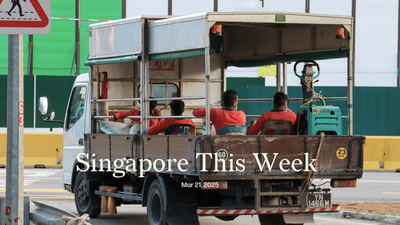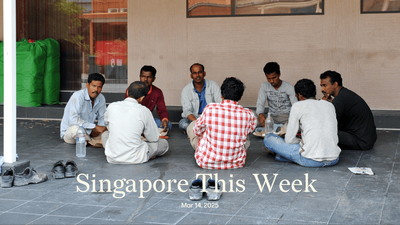Politics: Strength in numbers
Come together, small parties. In June, the Peoples Voice, the Reform Party, the People’s Power Party and the Democratic Progressive Party formed The People’s Alliance, allowing them to pool resources and theoretically offering them greater visibility, ahead of the next general election (GE), due by November 2025. This past week, another four parties, the National Solidarity Party, Red Dot United (RDU), the Singapore People’s Party, and the Singapore United Party formed The Coalition. In June, Elvin Ong, assistant professor of political science at the National University of Singapore and author of Opposing Power: Building Opposition Alliances In Electoral Autocracies, had said that a true opposition alliance is possible only if it includes the Workers’ Party (WP) and the Progress Singapore Party (PSP), the only two opposition outfits with seats in Parliament; it avoids three-cornered fights; and it has a common manifesto and campaigns jointly. The Coalition meets the latter two requirements. But even if its constituent parties don’t compete against each other, The Coalition—and, for that matter, The People’s Alliance–may still end up in three-cornered fights involving the ruling People’s Action Party (PAP), and one of the three brand name opposition parties: the WP, the PSP, and the Singapore Democratic Party (SDP). Though the PSP has in the past hinted at an alliance, there’s still no evidence that any of the big three, buoyed by their respective bases, will see the need for one. Indeed, with the PAP arguably in its weakest position since the late 1960s, they’ll each fancy their chances at the next GE. Some of the more intriguing contests will include the PSP’s attempt again to win the West Coast Group Representation Constituency (GRC) and the WP’s similar effort in the East Coast GRC. One of The Coalition’s more notable challenges will likely be in Jurong GRC, where in 2020 RDU’s chief Ravi Philemon led a team in what many considered a doomed mission—up against a PAP outfit led by the formidable Tharman Shanmugaratnam. Yet RDU managed to shave almost five percentage points off Tharman’s table-topping 79.28 percent win in 2015. The decline may have been partly due to overall disillusionment with the PAP and the disastrous about-turn over the fielding of Ivan Lim as a candidate. Still, Tharman’s recent decision to leave politics to contest in (and win) the presidential election has left a gaping hole that the PAP must fill, and which RDU will seek to exploit. It’ll be hoping that neither the PSP nor the SDP is also smelling blood.
Society: A new Singapore Dream?
It used to be the 5Cs—car, cash, condo, country club membership and credit card. But today, the Singapore Dream is formed of these aspirations instead: to shape a society that’s vibrant/inclusive; fair/thriving; resilient/united. These were revealed in the Forward Singapore Report, a 180-page doorstopper that distils the aspirations of more than 200,000 Singaporeans—over seven percent of the electorate—laying out a roadmap for how the Republic can achieve a more equitable future for its citizens. At the launch of the Forward Singapore Festival, Lawrence Wong, deputy prime minister and finance minister, noted that while Singaporeans still want a “good life”, the “refreshed” Singapore Dream is more than just material success, but also about “fulfilment, meaning and purpose”: less “I, me, and mine”; more “we, us, and ours.” The Forward Singapore exercise was launched last June, calling on Singaporeans to renew and strengthen its “social compact”—a term referring to the “glue that holds society together” that Wong made fashionable again after his Budget speech, last year. Faced with a new set of challenges and uncertainties—geopolitical tensions, technological advances, rising inequality, slowing social mobility, climate change and an ageing population—the road ahead won’t be easy, warned Wong, and change was inevitable. Firstly, this means “more opportunities” for citizens to chart their own path: empowering them to define their own ideas of success; for instance, one that’s more inclusive and embraces learning beyond grades. Secondly, more assurance that Singaporeans will be taken care of at “every life stage”, meeting basic needs like education, retirement, healthcare and housing. And lastly, greater “collective responsibility” from all stakeholders, including the government, businesses, community groups, families and individuals, to “support and uplift” those around them. Citizen empowerment, state welfare, and collective—rather than individual—responsibility are not concepts typically associated with the PAP. Is Wong for real? Supporters might point to his willingness to slay some sacred cows, such as (the lack of) unemployment benefits, and to Forward Singapore’s inclusive framing: visitors to its site are prompted to identify themselves as Business Leader, Caregiver, Parent, Person with Disabilities, Senior, Working Adult, or Youth. (Phew. No need to mention your race.) Cynics might sneer that it’s just a rehash of previous attempts at collaborative policymaking—including 2012’s Our Singapore Conversation and 2019’s Singapore Together—which ultimately seemed to function more as outlets for the disaffected rather than genuine attempts at citizen co-creation. Wong may also be tainted by the perception that his party is more aligned with the interests of the global elite, who can still attain the 5Cs, than ordinary Singaporeans, who increasingly can’t. If the old dream is no longer affordable, after all, it’s time for a new one.
Society: Sexual violence doesn’t discriminate
In the past week, three men have been convicted of committing three different forms of sexual violence: a former manager of a residents’ network under the People’s Association (PA) targeted an intellectually disabled girl and filmed himself sexually abusing her on several occasions; a 25-year-old man repeatedly threatened to upload nude photos of his ex-girlfriend, a 35-year-old woman; and a cleaner stalked, raped and assaulted a 23-year-old woman at a forested area in Kranji. A family friend, an ex-lover and a stranger. A minor and two adult survivors. A one-off incident versus repeated, varied forms of abuse. Two abusers inflicted violence in-person while the other employed the use of technology. Sexual violence doesn’t discriminate—it doesn’t only happen to any particular type of person, or in any specific neighbourhood; there is no reliable pattern of abuse, or definitive profile of a sexual abuser. In this article, Kontinentalist dispels some of these myths surrounding sexual violence in Singapore (eg. “It doesn’t happen here!”) by using data collected from news reports between 2017 to 2021. Simply put, there is nothing we can do to “guarantee” safety from sexual violence. But finding fault in a survivor’s behaviour, or “victim-blaming”, has very real effects. The minor who had suffered at the hands of the former PA manager “blamed herself for what had happened, and became scared of her grandaunt, who initially blamed the victim for being victimised”. Another survivor “distanced herself” from family and friends, and “did not tell her parents about the incident out of shame”. Because of the stigma attached to sexual abuse survivors, gag orders are often placed by the Attorney-General’s Chambers to protect the survivor’s identity. This prevents re-victimisation, where survivors suffer twice: once during the crime, and then again in the court of public opinion or while testifying. But there is an inherent, unresolvable tension between gag orders and open justice, according to the late Adrian Tan, former President of Law Society Singapore and Partner at TSMP Law Corporation. Protecting the identity of the survivor simultaneously protects the perpetuator, who some think should be identified so others can be protected from them. Of the three aforementioned cases, two gag orders were placed while the name and nationality of one perpetrator, in the Kranji incident, was revealed. As we strive towards building a safer society, it’s important for us to move away from victim-blaming and towards empathetic, survivor-focused modes of justice.
The Association of Women for Action and Research (AWARE) provides specialised services to support victims and survivors of sexual assault via their Sexual Assault Care Centre.
History weekly by Faris Joraimi
Two weeks ago, over 800 scholars and practitioners of international law, conflict studies and genocide studies warned about the potential of genocide in Gaza. They noted, among other things, that the “language used by Israeli political and military figures appears to reproduce rhetoric and tropes associated with genocide and incitement to genocide.” As Western powers line up to enable this in Palestine (televised daily on our phones), it’s worth recalling Algeria’s war of independence, which began 69 years ago this week: November 1st 1954. But did the violence begin on that date? France first invaded Algeria, then part of the Ottoman Empire, in 1830, before brutally occupying it for over 120 years. Europeans settled on lands formerly owned by the indigenous Muslims. They became a privileged minority dominating the local economy and politics. Following the second world war, the National Liberation Front (Front de Liberation Nationale, or FLN) was formed to overthrow the colonial regime. Initially, the FLN’s fighters targeted only military and government outposts, but with robust French counter-insurgency measures, the FLN began attacking civilians as well. Inspired by nationalist revolutions in Asia, they employed guerrilla tactics, conducting assassinations and bombings. Backed by the US, the French reprisal exacted far many more deaths, and involved atrocities from rape and systematic torture to starvation and forced labour. Some 400,000 French soldiers were deployed by 1956. The philosopher Albert Camus, a member of Algeria’s European settler community, advocated against civilian killings on both sides. French public opinion at home turned against the growing horror being committed in their names, as did that of the international community. Eighteen members of the UN, including Indonesia, the Philippines and the newborn Federation of Malaya, submitted a joint draft resolution recognising Algeria’s right to self-determination, and calling on France to open negotiations, which it finally did in 1961. Algeria was liberated in 1962 at the cost of 400,000 to 1.5m Algerian lives and some 31,000 French ones (25,000 soldiers and 6,000 civilians). The situation in Palestine has important differences, but a key similarity is the way the body count is quickly rising even in the face of public opposition to the war globally. International opinion is again divided along First World-Third World lines. With the UN embattled and ineffectual, the risk that we’re sleepwalking into the colossal tragedy the scholars have worried about is real.
Arts: I spy with my little eye, Peter Yu at SGIFF
If you’re planning to watch “Last Shadow at First Light”, “Dreaming & Dying”, “Wonderland”, “Snow in Midsummer” and “A Year of No Significance” at the Singapore International Film Festival (SGIFF) this year, then you might spot someone in common across all five films—Peter Yu. The Singaporean actor is, according to director Kelvin Tong in an interview with 8days.sg, “fast becoming the (Tony) Leung Chiu Wai of Singapore”. All five films cover vastly different themes and genres. “A Year of No Significance” is a realist drama set in the 1970s that depicts a man’s efforts to contend with wrenching socio-economic change in Singapore. “Snow in Midsummer” references a particular point in history, exploring the trauma of Malaysia’s ‘513’ incident (May 13th 1969) and the way it permeates the present. “Dreaming & Dying”, a film in which a school reunion recalls repressed desires and entangled memories, has an element of magical realism. “Wonderland” and “Last Shadow at First Light” both explore familial relationships. Three of these five films—“Dreaming & Dying”, “Last Shadow at First Light” and “Snow in Midsummer”—have been recognised at international festivals and award ceremonies, and are also part of SGIFF’s Asian Feature Film Competition, which showcases works by the most promising directors of this generation working in Asia. SGIFF opens on November 30th and runs till December 10th. For tickets and/or more information about the films, please visit https://sgiff.com.
Arts: Reaching across realms with Salty Xi Jie Ng
How do we remember our ancestors? How do we reach them, from this realm to the one they occupy now? These are the questions that Salty Xi Jie Ng addresses time and again in her practice. Her new exhibition, “across the way”, which opens at starch on November 11th, showcases the artist’s interdimensional practice and her body of work as the Baibai Research Group (BBRG). Curated by Kimberly Shen, the exhibition features works by Ng and multiple collaborators, as well as several public programmes centred on reimagining ancestral relationships and ancestor worship. Several works are anchored around the idea of “dream visitations” or 托梦 (tuo meng), which are portals between realms. Ng’s work “Ancestor Dream Visitation Repository” is a research experiment collecting, theorising and translating ancestor dream visitations towards new notions of lineage, remembrance and spirituality. Collaborators Shawn Creeden, ila and Anise have contributed chants for ancestor, deity and plant dream visitations for a work titled “dream visitoration temple 托梦殿”. Other works are connected with Ban Kah Hiang, a historic Chinese religious goods merchant. The business provides its customers with religious goods for rituals and keeps knowledge of Chinese religious practices and traditions alive. “across the way” speaks to humanity’s desire and longing to communicate with the departed, seeking affirmation, guidance, and divine intervention. For more information on the exhibition and public programmes, visit their event page.
Note: For the next week, Jom’s August 2022 profile of the artist, “Salty Xi Jie Ng seeks to provoke”, will be outside the paywall.
Tech: Sandbox for generative AI
Government agencies haven’t missed out on the hype around the latest generative artificial intelligence (AI). From increasing access to justice to transforming education, various politicians and civil servants have articulated how they think their agencies can leverage generative AI to transform the delivery of products and services. Regulators are stepping in too, with the Infocomm Media Development Authority (IMDA) and the AI Verify Foundation announcing the launch of the Gen AI Evaluation Sandbox. This initiative seeks to support the advancement and incorporation of reliable generative AI products. One of the Sandbox’s features is its focus on addressing potential risks and difficulties associated with generative AI technology, such as algorithmic bias, misinformation, and the production of harmful content. Several prominent companies, including Google, Microsoft, Amazon Web Services, Singtel, and Resaro.ai, have pledged to participate in this project. The Sandbox utilises a new evaluation catalogue, which offers common methodologies and advice for evaluating large language models, and serves as a testing reference for generative AI products. Other regulatory entities like the Personal Data Protection Commission will offer a platform for experimentation and development alongside the Sandbox initiative. It’s anticipated that the project will contribute to developing new benchmarks and testing procedures for AI use in various sectors. It’s important that the Singapore government starts thinking about regulations and benchmarks for generative AI, given that it’s one of the most proactive in terms of adopting generative AI for public service delivery. Most recently, the government announced a plan to build 100 generative AI solutions in 100 days and decisively moved public facing chatbots onto large language models.
Tech: SPH Media acquires Tech in Asia
Hardware Zone and Tech in Asia (TIA) now have the same parent. SPH Media will acquire the region’s leading technology media company with the aim of strengthening its business and technology news coverage, particularly at The Business Times. The acquisition is part of SPH Media’s broader transformation efforts and is expected to provide growth opportunities for both companies without leading to worker layoffs. TIA’s 90 personnel, based in Singapore, Indonesia, and throughout the Asia-Pacific region, will retain their roles as TIA becomes a subsidiary of SPH Media. While the financial terms of the deal haven’t been disclosed, both companies have expressed optimism about their new partnership. SPH Media’s editor-in-chief, Wong Wei Kong, sees the acquisition as a strategic move to enrich the array of products and services for their readership. Meanwhile, Willis Wee, TIA’s founder and CEO, expressed enthusiasm for the opportunities the acquisition will bring, and asserted that TIA’s start-up spirit and data-driven approach will persist in the merged entity. Wee also noted that the acquisition would reward employees and investors, including East Ventures, Y Combinator and Softbank. Will it be business as usual post-merger? Naturally, questions around the journalistic independence of the outfit will arise given the various investigative pieces it has produced over the years on companies such as Zilingo, Honestbee, One Championship and GudangAda. (SPH Media, which is heavily reliant on corporate advertising, is not known for such rigorous interrogations of firms.) As with most mergers and acquisitions, we’ll have to wait and see how many employees remain after the integration process to determine if there’s alignment between the two outfits.
If you enjoy Jom’s work, do get a paid subscription today to support independent journalism in Singapore.







